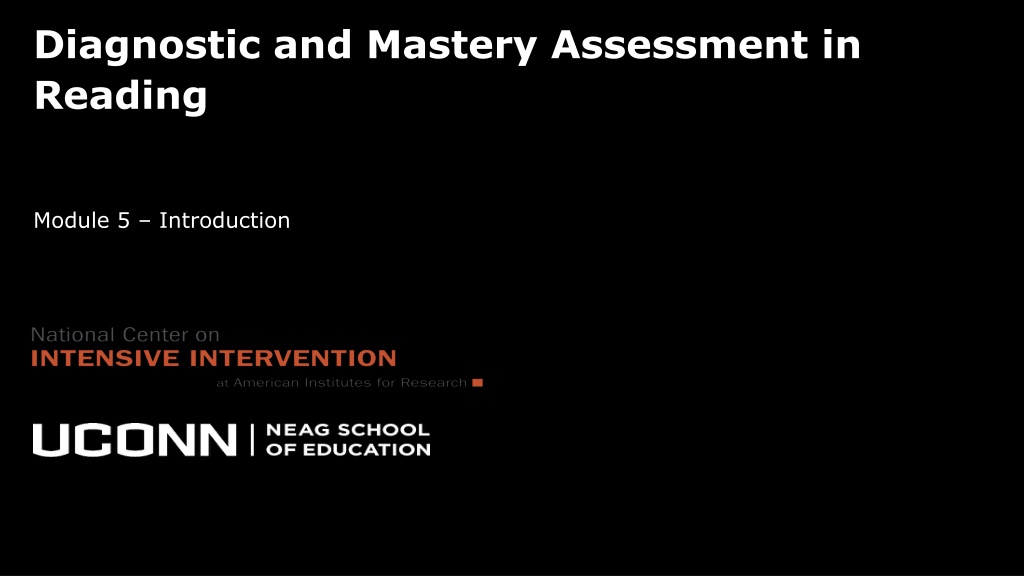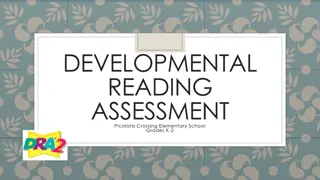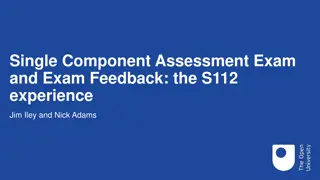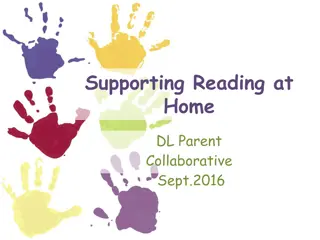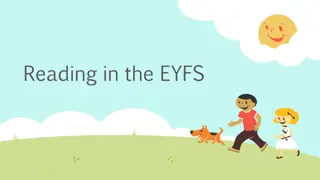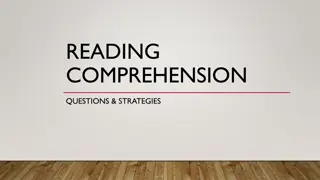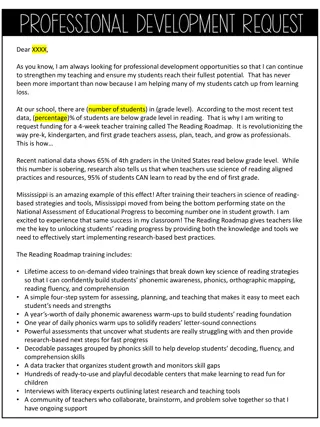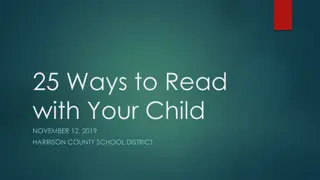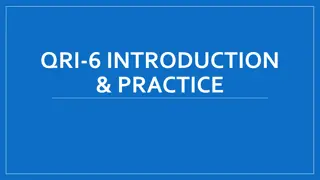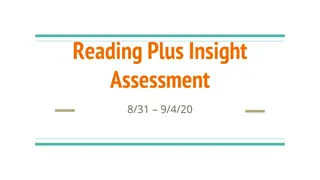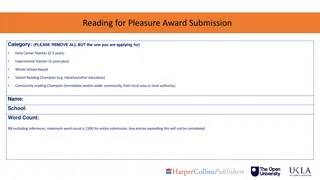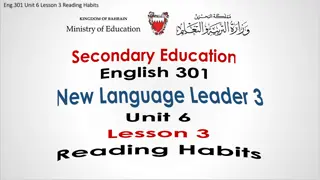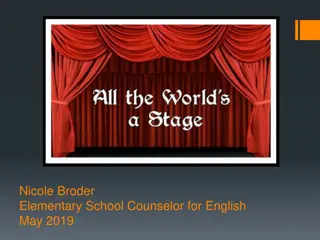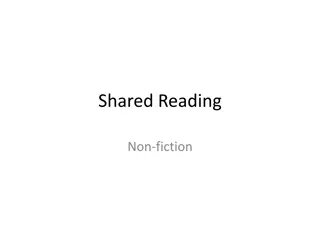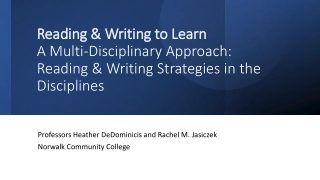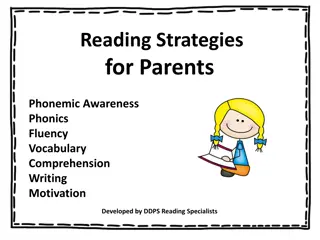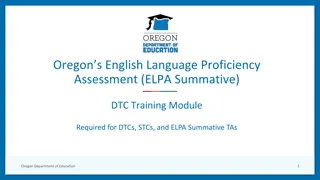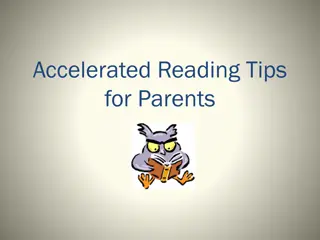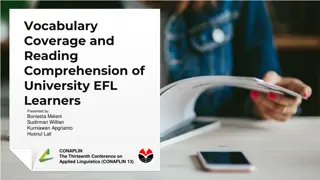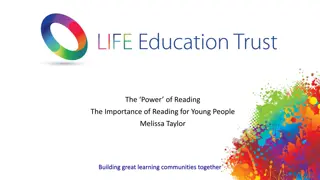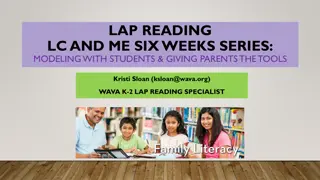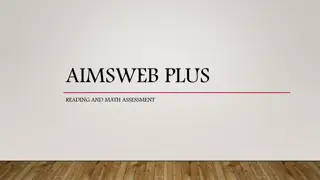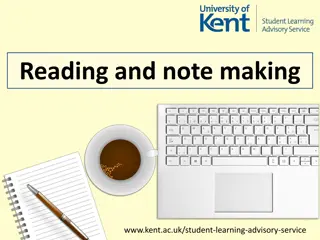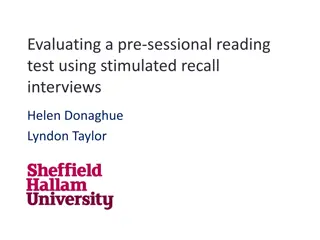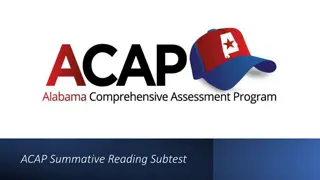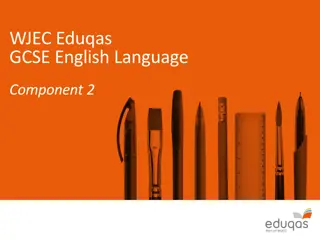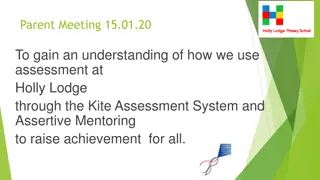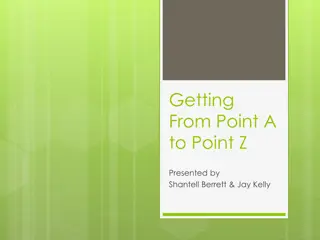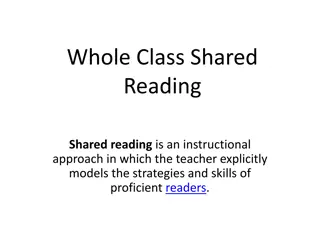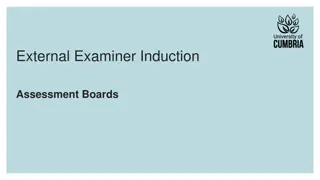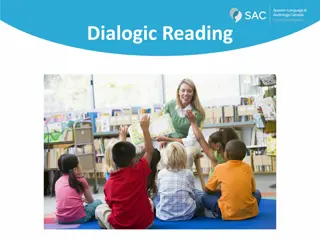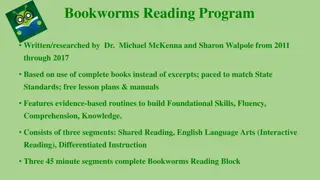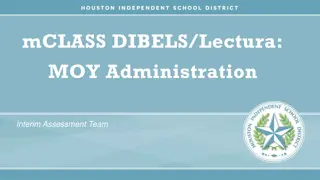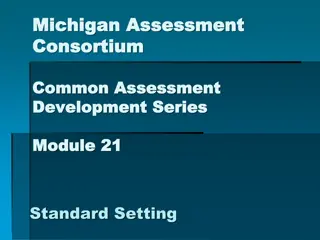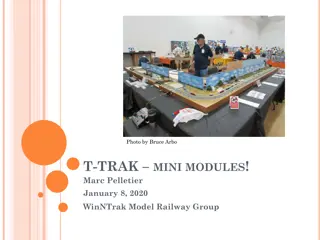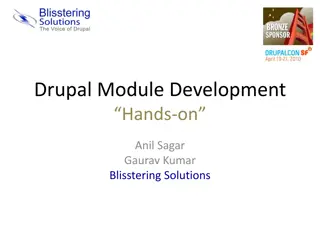Comprehensive Module on Reading Assessment Strategies
This module covers diagnostic assessment, curriculum-based assessment, integrating data for instruction, and progress monitoring in reading. Learn specific skills to teach, use assessment probes, and adapt instruction based on diagnostic data. Explore tools like CBM and mastery measures to evaluate student progress.
- Reading Assessment
- Diagnostic Assessment
- Curriculum-Based Assessment
- Progress Monitoring
- Instructional Adaptations
Download Presentation

Please find below an Image/Link to download the presentation.
The content on the website is provided AS IS for your information and personal use only. It may not be sold, licensed, or shared on other websites without obtaining consent from the author. Download presentation by click this link. If you encounter any issues during the download, it is possible that the publisher has removed the file from their server.
E N D
Presentation Transcript
Diagnostic and Mastery Assessment in Reading Module 5 Introduction
Overview Part 1: Diagnostic assessment Part 3: Curriculum-Based Assessment (CBA) Part 4: Integrating Diagnostic and Progress Monitoring Data to Inform Instruction Closing: What are the next steps? Note: There is no Part 2 in this module. The content originally covered in Part 2 is covered in other modules.
Objectives You will learn how to Part 1: Identify specific reading skills or strategies that you need to teach Part 3: Develop and use curriculum-based assessment (CBA) probes to help refine instructional focus and determine if students are learning what is taught Part 4: Use diagnostic data to inform content of instructional adaptations Closing: Bring everything together to inform instructional adaptations when indicated by progress monitoring data
Lets add reading to the model How are students responding to intervention (within big idea areas of reading)? CBM (General Outcome Measure) Diagnostic Assessment (e.g., CORE Assessment Battery) What specific reading skills or strategies do I teach? How do I refine my instructional focus and determine if students are mastering what I teach? Specific Skills CBM with Error Analysis + Curriculum-based Assessment (CBA) 5
A review of progress monitoring tools General outcome measures (GOM), such as CBM Evaluate overall progress toward meeting the grade-level expectations Example: Word identification fluency for first grade Sample the range of skills for a grade Example: Math concepts and applications for a specific grade Should be tested by researchers Mastery measures Evaluate progress toward mastery of a specific skill that is only part of what is expected in that subject Can be designed by teachers, given some assistance
CBM or mastery? Mastery CBM CBM knowledge of particular letter sounds phonemic segmentation fluency oral reading fluency 7
Distinguishing types of assessments in reading General Outcome Measures (CBM) Identifies specific reading skills to teach Diagnostic Assessment (e.g., CORE Assessment Battery) Mastery Measures Specific Skills CBM with Error Analysis + Curriculum-based Assessment (CBA) Indicates whether or not I need to refine how I am teaching. 8
DBI in reading requires the strategic use of both CBMs and mastery assessment Mastery Measures CBMs Phonemic Segmentation Fluency Diagnostic Examples CBMs with Error Analysis Nonsense Word Fluency What is the purpose of Assessment? Curriculum-based Assessment (CBA) Oral Reading Fluency Global Indicators Mastery Indicators Features High Technical Adequacy Representative of Specific Skills Drilling Down! Efficient
The Big Picture Revisit Case Study: Zane 3rd Grade Receives Special Education Services for Learning Disability Reading 25 minutes of small group instruction 3x a week Strengths Weaknesses Motivated to read especially about animals Fluency Receptive to corrective feedback Frequently guesses at words, errors increase when text is not in an interest area Consistent difficulties with affixes and multisyllabic words Has made a lot of progress in decoding from words lists
The Big Picture Revisit Case Study: Zane What to target? Use Diagnostics Zane s teacher, Ms. Smith, decides to continue explicit phonics instruction, phonemic awareness, and word attack. She also decides she really needs to increase his practice with passage reading and fluency, incorporating repeated oral reading, partner reading, and guided reading. However, Ms. Smith isn t sure where to start with her phonics instruction or what his independent and instructional reading levels are. Thus, Ms. Smith decides to administer several diagnostic assessments to Zane in order to decide what to teach She uses the CORE Phonics Survey.
The Big Picture Revisit Case Study: Zane After 7 Weeks of Instruction Zane needs a change to instruction 120 100 80 Goal Int 1 60 Linear (Goal) Linear (Int 1) 40 20 0 3-Sep 3-Oct 3-Nov 3-Dec 3-Jan 3-Feb 3-Mar 3-Apr 3-May
The Big Picture Revisit Case Study: Zane With additional time, Zane is still not responding 120 100 80 Goal Int 1 60 int 2 Linear (Goal) Linear (int 2) 40 20 0 3-Sep 3-Oct 3-Nov 3-Dec 3-Jan 3-Feb 3-Mar 3-Apr 3-May
The Big Picture Revisit Case Study: Zane What to do? Ms. Smith: Has been using mastery assessments as she has gone and notes that Zane is reading the specific word types she has taught in word lists. Looks at Zane s errors on his ORF and notes that, although he is reading the instructed word types in word lists to mastery, he is still making errors on the word types within passages (ORF). Again uses the Core Phonics Survey and finds his performance to be very similar to his first attempt at the diagnostic assessment. This indicates that Zane is also struggling with maintenance.
Activity 5.1: Pause & Process Turn to your workbook and answer the following questions: 1. What forms of assessment do you currently use? 2. Of the assessments you currently use, what type are they (CBM or Mastery)? 3. How do the different types of assessment you currently use influence your instruction?
Diagnostic assessment Module 5 Part 1
Part 1 Objective You will learn how to: Identify specific reading skills or strategies that you need to teach
Lets look at diagnostic assessment General Outcome Measures (CBM) Diagnostic Assessment (e.g., CORE Assessment Battery) Specific Skills CBM with Error Analysis + Curriculum-based Assessment (CBA) 18
Diagnostic assessment Aligns with big ideas in reading Is used to inform instructional planning Helps determine areas of strength and areas of instructional need Is criterion-referenced. . . What specific reading skills do I teach?
Criterion-referenced These assessments are intended to determine whether or not a student has mastered a certain set of skills (90% accuracy or better). Once the student has mastered the skills, different criterion (e.g., different skills) need to be assessed. EXAMPLES: An assessment may identify what letter names the student has mastered and which ones the student has not. Once the student has mastered all letter names then this assessment is no longer needed. *HOWEVER, you may do an occasional letter name probe to be sure the student has maintained their letter name knowledge. Skills that are assessed should be the skills needed for proficient reading and this tells the teacher what content on which they need to focus their instruction.
For example: CORE Literacy Library Phonological Awareness Decoding and Word Attack Spelling Fluency Vocabulary Comprehension Aligns with big ideas in reading for K-12. Consortium on Reading Excellence (2008). Assessing reading: Multiple measures for all educators working to improve reading achievement. Novato, VA: Arena Press.
CORE Phonics Survey Record Form Skills to review:_____________________ ____________________________ ____________________________ ____________________________ Skills to teach:______________________ ____________________________ ____________________________ ____________________________ Is used to inform instructional planning
CORE Reading Assessment Profile, Grades 4-8 FALL WINTER SPRING ___/___ ___/___ ___/___ CORE Reading Maze Comprehension MASI-R Oral Reading Fluency Measures (Through Grade 6 Only) Benchmark: 50th percentile, in WCPM, +/- 10 wcpm____ Target = 71 wcpm____ Target = 92 wcpm___ Target = 107 ___/___ ___/___ ___/___ CORE Vocabulary Screening Helps determine areas of strength and need San Diego Quick Assessment of Reading Ability Independent Level: 1 error Instructional Level: 2 errors Frustration Level: 3+ errors CORE Graded High Frequency Word Survey Benchmark: 21-24 Strategic: 18-20 Intensive: 0-17 ____/20 ____/20 ____/20 CORE Phoneme Deletion Test (Administered if indicated by results on other tests.) ____/15 ____/15 ____/15 CORE Phoneme Segmentation Test (Administered if indicated by results on other tests.) CORE Phonics Survey Reading and Decoding (Administer E K as diagnostics if indicated) Short vowels in CVC words Consonant blends with short vowels Short vowels, digraphs, and tch trigraphs R-controlled vowels Long vowel sounds Variant vowels Low frequency vowel and consonant spellings Multisyllabic words ____/15 ____/15 ____/15 ____/15 ____/15 ____/15 ____/15 ____/24 ____/15 ____/15 ____/15 ____/15 ____/15 ____/15 ____/15 ____/24 ____/15 ____/15 ____/15 ____/15 ____/15 ____/15 ____/15 ____/24
Other Resources More examples and links can be found at the National Center on Intensive Intervention: https://intensiveintervention.org/intensive-intervention/diagnostic-data/example-diagnostic- tools Do you want to learn more? https://intensiveintervention.org/intensive-intervention/diagnostic-data
Activity 5.2 Quiz In your workbook, answer the following question. Which of the following statements are true? Check your answers. Diagnostic assessments align with big ideas in reading are used to inform instructional planning help determine areas of strength and areas of instructional need are criterion-referenced
Activity 5.2 Quiz Review In your workbook, answer the following question. Which of the following statements are true? Check your answers. Diagnostic assessments align with big ideas in reading are used to inform instructional planning help determine areas of strength and areas of instructional need are criterion-referenced
Activity 5.3 Stop & Jot In your workbook, complete the following assignment. 1. Review a scored copy of the CORE Phonics Survey. 2. Give examples to illustrate how this diagnostic assessment: a. aligns with the big ideas in reading b. is used to inform instructional planning c. helps determine areas of strength and areas of instructional need d. is criterion-referenced 3. Would you spend your time teaching letter names? Why or why not? 4. What decoding skills would you first target in your instruction?
Activity 5.3Stop & Jot continued Take a few moments to examine the student s performance on this part of the CORE. See if you can identify patterns of mistakes within each section (B, C, D, E). What would you target first in instruction? Second?
Curriculum-Based Assessment (CBA) Module 5 Part 3
Part 3 Objective You will learn how to: Develop and use curriculum-based assessment (CBA) probes to help refine instructional focus and determine if students are learning what is taught
Well continue thinking about specific skills General Outcome Measures (CBM) Diagnostic Assessment (e.g., CORE Assessment Battery) Specific Skills CBM with Error Analysis + Curriculum-based Assessment (CBA) 32
Curriculum-Based Assessment (CBA) Describe mastery of a single skill in a series of short-term instructional objectives. Represent a logical, not an empirical hierarchy of skills. Are often district/school developed probes of content mastery. Include multiple equivalent probes that sample from key skill(s) in unit/intervention. Used to document mastery of specific content/skills. Can document progress toward curriculum goals (e.g., given 10 nonwords with vowel digraphs and dipthongs, student A will correctly read 10/10 over 3 consecutive days). (National Center on Intensive Intervention) 33
Curriculum-Based Assessment (CBA) Curriculum-based assessment may be defined as the practice of obtaining direct and frequent measures of a student s performance on a series of sequentially arranged objectives derived from the curriculum used in the classroom. (Idol, 1983; Blankenship, 1985)
CBA . . .is highly instructionally-aligned and often integrated with instruction. Sometimes it s even hard to tell what is instruction and what is assessment.
Difference between CBA & CBM? CBM Assess general performance within a content area (reading, math, writing) Researcher created and standardized Are predictive of overall performance with standardized assessments CBA Assess progress in learning specific skills/curriculum (reading CCVC words) Typically teacher created Validity depends upon the skill(s) of the teacher unknown Purpose: Creator: Validity:
What do mastery probes look like? Given a two-page narrative with grade level text, Jorge will correctly fill in story map (e.g., 11 out of 12 possible points) over two consecutive trials.
What do scoring criteria look like? Probe: cake, kite, make, snake, bike, rate, like, lake, fake Criterion: -Decode 9/10 or 10/10 words for mastery. -Decode 8/10 words to 7/10 words for instructional level. -Decode 6/10 words or less for failure level; assess prerequisite skill level: discrimination of long/short vowels (vowels: a, i).
CBAkey components Define the specific literacy skill(s) you are assessing and how frequently assessment will occur Provide a lesson/unit objective that is measurable Include criteria for mastery Develop administration directions to ensure uniformity Select items that test the specific skill(s) Create assessments by randomly selecting a pre-set number of items
An example of how we create and use CBA probes. . . Select material for assessment Material must be aligned with singular learning objective Material must be on the student s instructional level Create alternative forms Determine scoring Implement CBA assessment Pre During Post Review student assessment performance Are students performing at mastery, instructional, or frustration levels?
Select material for assessment Curriculum Kindergarten early reading curriculum Assessment Identify 5 randomly selected words, from a list of words that start with m, p, f, c, t, s, d, and l, for pre/post and weekly assessment. Lessons 1-25 When given a word, students will write the letter that corresponds to the first sound. Identifying first sounds m, p, f, c, t, s, d, l
An example of how we create and use CBA probes. . . Select material for assessment Material must be aligned with singular learning objective Material must be on the student s instructional level Create alternative forms Determine scoring Implement CBA assessment Pre During Post Review student assessment performance Are students performing at mastery, instructional, or frustration levels?
Create alternative probes When given a word, students will write the letter that corresponds to the first sound. 1 point/correct response. List 1 List 2 List 3 List 4 List 5 List 6 map pig fan sun tap dad lap tap cat can fun mop sat mud lid man sum Sam lot fat fan lip Dan tag cap pat tab tip mom sip
An example of how we create and use CBA probes. . . Select material for assessment Material must be aligned with singular learning objective Material must be on the student s instructional level Create alternative forms Determine scoring Implement CBA assessment Pre During Post Review student assessment performance Are students performing at mastery, instructional, or frustration levels?
Implement CBA assessment Phonological Awareness/Spelling Unit Lessons 16-20 Lessons 21-25 Lessons 26-30 Lessons 11-15 Lessons 6-10 Lessons 1-5 Probe 5 (During) Probe 4 (During) Probe 3 (During) Probe 6 (Post) Probe 2 (During) Probe 1 (Pre) Week 5 Week 2 Week 3 Week 4 Week 1
An example of how we create and use CBA probes. . . Select material for assessment Material must be aligned with singular learning objective Material must be on the student s instructional level Create alternative forms Determine scoring Implement CBA assessment Pre During Post Review student assessment performance Are students performing at mastery, instructional, or frustration levels?
Review student assessment performance Are students performing at mastery, instructional, or frustration levels? Levels Independent (Mastery) Instructional Frustration 90-100% known 70-85% known Below 70%
Select material for assessment Curriculum Fourth grade spelling curriculum. Approximately 400 words are taught in the curriculum. Assessment Randomly select 20 words, from the total 400 words, for pre/post and weekly assessment.
Create alternative probes List 1 List 3 List 2 deal land those bubble meant travel price whistled upon best making hard classes tease world one during screen weekly partly cities we ve suddenly busiest car finer putting Monday circus scold thousand nail thirty scare august shoes ours proud aged doesn t toothbrush chicken together quite plenty again chain more add follow man oil sack show fifteen mouse spray women mean wrong
